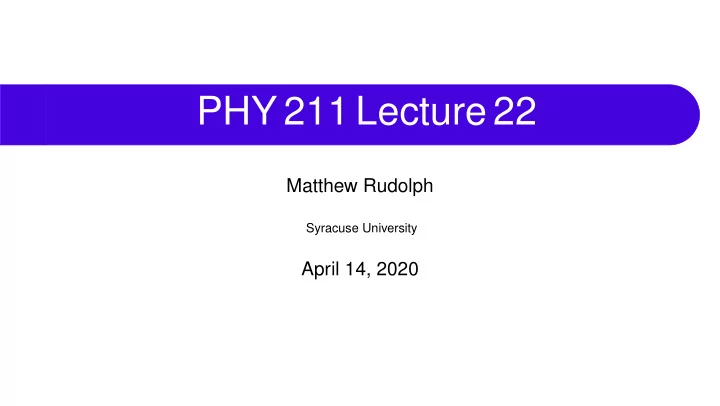

PHY 211 Lecture 22 Matthew Rudolph Syracuse University April 14, 2020
Rotation We talked a bit earlier in the semester about rotational coordinates, torque and angular acceleration But what about the energy of the system? 2 / 21
Setting up rotation Thinking of rotation as lots of little linear motions is difficult Better to define new, rotating coordinates Turns a constantly changing 2D problem into a 1D problem position: x angle: θ velocity: v = d x angular velocity: ω = d θ d t d t acceleration: a = d v angular acceleration: α = d ω d t d t 3 / 21
Circular motion y ω � v 2 � v 1 θ x 4 / 21
Beyond describing motion We’ve learned a lot since we first encountered these variables How will we describe energy and forces in this picture? This is motion, so it should have kinetic energy! This is our main focus for now Some things are harder to turn than others: moment of inertia 5 / 21
Kinetic energy y Take a point mass going around a circle � ω We can already calculate its kinetic energy � r θ K = 1 2 mv 2 x = 1 2 m ( ω r ) 2 = 1 � mr 2 � ω 2 2 6 / 21
Pre-lecture question 1 If a child walks toward the center of a merry-go-round, does the moment of inertia increase, decrease, or stay the same? (a) Increase (b) Decrease (c) Stay the same 7 / 21
Pre-lecture question 2 Is it easier to spin a rod around its center or its end? (a) Center (b) End 8 / 21
Pre-lecture question 3 An object that is spinning in place has no kinetic energy. (a) True (b) False 9 / 21
Moment of inertia The rotational equivalent of mass is moment of inertia, I For any object it will be something × mr 2 (where r is some length) Rotational kinetic energy K = 1 2 I ω 2 10 / 21
Doing the calculation Adding up the moment of inertia fundamentally involves integration But we don’t have to redo the integral for every configuration – remember I depends both on object’s shape and on the axis of rotation First get I for various common shapes around their center of mass Ring Square Disk I = 1 2 mr 2 I = 1 r 2 1 + r 2 I = 1 6 ma 2 � � 2 m 2 11 / 21
12 / 21
13 / 21
Moving the axis The key thing is that once we know I around the center of mass, it’s easy to find around any parallel axis Parallel axis theorem I = I CM + md 2 d is the distance between the CM axis and the actual axis of rotation We can break up an object into shapes for which we know I CM , then each one contributes an extra bit of I based on where its CM is located 14 / 21
Example All motion is rotational A uniform rod of mass 1 . 0 kg and length 2 . 0 m is free to rotate about one end (see the following figure). If the rod is released from rest at an angle of 60 ◦ with respect to the horizontal, what is the speed of the tip of the rod as it passes the horizontal position? 15 / 21
Linear and rotational motion An object can rotate and have the center of mass move, in which case total is K = 1 CM + 1 2 mv 2 2 I ω 2 Motion of the center of mass is also called “translational” If it is rotating on a fixed axis don’t write down mv 2 / 2 For now we will only consider fixed rotation and “rolling without slipping” 16 / 21
Rolling without slipping Rolling without slipping is one of the cases where v = ω r ∆ x ∆ x • v CM = ∆ x ∆ t = ( r ∆ θ ) = ω r ∆ t 17 / 21
What wins a race down the ramp? Remember that for sliding down a ramp, the acceleration did not depend on mass What about differently shaped rolling objects? Which will win in each of these scenarios? 18 / 21
Rolling down the hill A solid disk with a mass m and a radius r rolls without slipping down an incline starting from a height h . What is its speed at the bottom? 19 / 21
A block of mass m 1 = 4kg is suspended on a light non-stretchable string wound around a pulley with mass m 2 = 3kg (assume solid cylinder) which rotates in place while the block is descending. If the block starts from rest and then falls 1 . 0 m, what will be its velocity? 20 / 21
A solid sphere of radius 10 cm is allowed to rotate freely about an axis. The sphere is given a sharp blow so that its center of mass starts from the position shown in the following figure with speed 15 cm / s. What is the maximum angle that the diameter makes with the vertical? 21 / 21
Recommend
More recommend